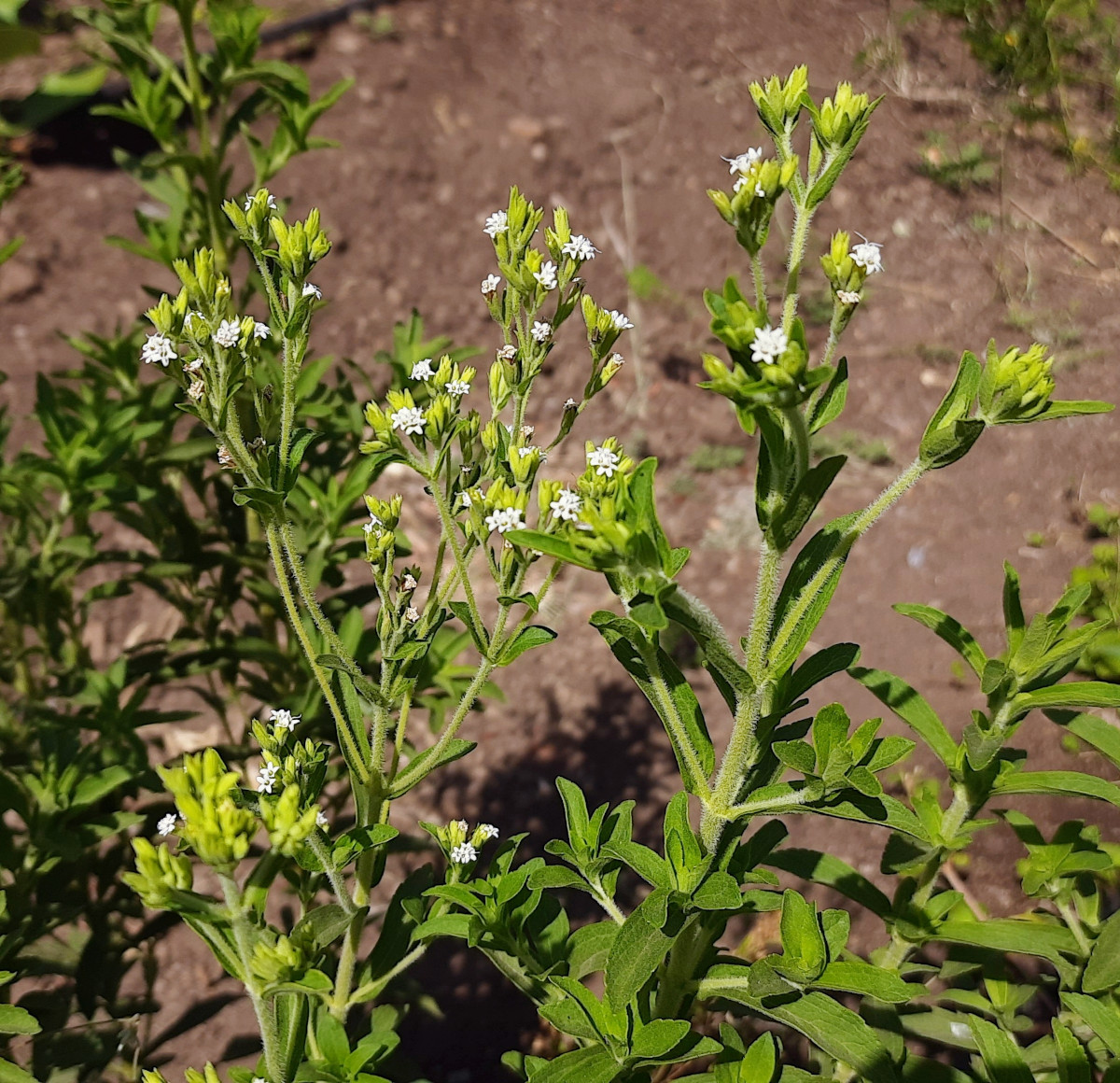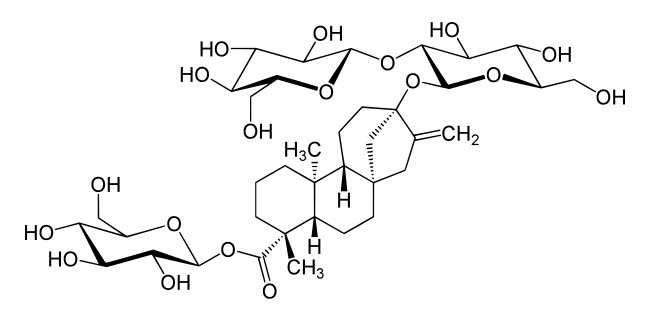Stevia rebaudiana Bert. - syn.Eupatorium rebaudianum Bert. - Asteraceae
ka'a he'ẽ (guaraní), stevia, sweetleaf, „Sweet herb of Paraguay“, Stevia
Annual or biennial herb, up to 80cm high, native to South America (Paraguay, Brazil); stem slightly woody; rootstock with many dormant shoots; leaves opposite, simple, ovoid to elliptic, 2-3cm long and 1.5cm wide, margin slightly dentate; flowers small, white, 2-6 together.
„Sixteen trained tasters provided sweetness and bitterness intensity ratings for 19 compounds including: acesulfame-K, alitame, aspartame, fructose, glucose, glycine, lactitol, maltitol, monoammonium glycyrrhizinate, neohesperidin dihydrochalcone, neosugar (fructo-oligosaccharide), palatinit (isomalt), rebaudioside-A, sodium cyclamate, sodium saccharin, stevioside, sucralose, sucrose, and thaumatin. With increasing concentration, high-potency sweeteners including acesulfame-K, neohesperidin dihydrochalcone, sodium saccharin, rebaudioside-A, and stevioside tended to become more bitter. Low-potency sweeteners including fructose, sucrose, and lactitol tended to become less bitter with increasing concentration.“
[Bitterness of sweeteners as a function of concentration., Schiffman, S.S., Booth, B.J., Losee, M.L., Pecore, S.D., Warwick, Z.S., Brain research bulletin, Vol.36(5), 1995, 505-513]
Steviol glycosides of the ent-kauran type are responsible for the sweet taste of the leaves of S.rebaudiana. Stevioside is 110-270 times, Rebaudioside A between 150 and 320 times sweeter than sucrose, Rebaudioside C between 40 and 60 times, and Dulcoside A was found to be 30 times sweeter than sucrose. „Typical proportions, on a dry weight basis, for the four major glycosides found in the leaves of wild stevia plants is 0.3% dulcoside, 0.6% rebaudioside C, 3.8% rebaudioside A and 9.1% stevioside.“
[Stevia rebaudiana: its agricultural, biological, and chemical properties., Brandle, J.E., Starratt, A.N., Gijzen, M., Canadian journal of plant science, Vol.78(4), 1998, 527-536]
http://pubs.aic.ca/doi/pdf/10.4141/P97-114
In samples of S.rebaudiana from Northeastern Argentina, the stevioside content (weight) was 3.7-9.7%, Rebaudioside A content was 1.6-7.2%.
[Analysis of sweet diterpene glycosides from Stevia rebaudiana: Improved HPLC method., Kolb, N., Herrera, J.L., Ferreyra, D.J., Uliana, R.F., Journal of agricultural and food chemistry, Vol.49(10), 2001, 4538-4541]
„The plant was used extensively by Gaurani Indians for more than 1500 years. Stevia has a long history of medicinal use in Paraguay and Brazil, and while many of the therapeutic applications of Stevia are anecdotal, they must be considered in that they have spanned generations. There are now known to be more than 150 Stevia species but this is the only one with significant sweetening properties; other species do contain other biochemicals of interest. Leaves contain approximately 4-15% of steviosides, which are intensely sweet compounds (150-300 times sweeter than sugar)…
Stevioside is not absorbed by the human gut; only bacteria of the colon degrade stevioside to steviol. Part of this steviol is absorbed by the colon and transported to the liver by portal blood. In the liver, steviol glucuronide is formed, which is released into the blood and filtered out by the kidneys into the urine. High levels of steviol glucuronide in the urine suggest that there is no accumulation of steviol derivatives in the human body.
Medium-polar leaf extract of S. rebaudiana (200 and 400 mg/kg) produced a delayed but significant (P < 0.01) decrease in the blood glucose level, without producing condition of hypoglycemia after treatment, together with lesser loss in the body weight as compared with standard positive control drug glibenclamide…
Stevia extract produced good antidiabetic effects together with lesser loss in body weight. Thus, purified Stevia sweeteners can also be used in the preparation of cough syrups and cold beverages for diabetes patients.“
[Antidiabetic activity of medium-polar extract from the leaves of Stevia rebaudiana Bert.(Bertoni) on alloxan-induced diabetic rats., Misra, H., Soni, M., Silawat, N., Mehta, D., Mehta, B.K., Jain, D.C., Journal of Pharmacy and Bioallied Sciences, Vol.3(2), 2011, 242]
http://www.ncbi.nlm.nih.gov/pmc/articles/PMC3103919/

Stevia rebaudiana, Pune, India (2024) © bhagwatn CC BY-SA 4.0 inaturalist.org

Hooker, W.J., Hooker, J.D., Icones Plantarum [Hooker’s] Icones plantarum], vol.29, t.2816 (1906) [M. Smith]
http://plantgenera.org/species.php?id_species=979061

